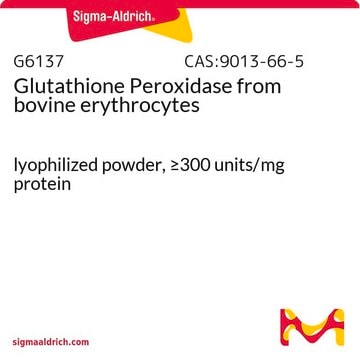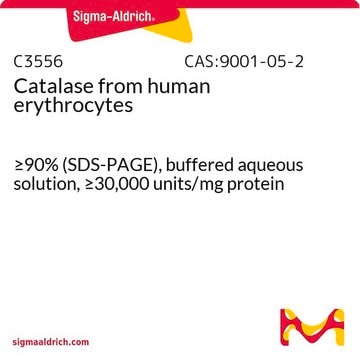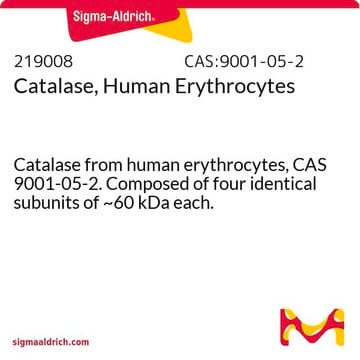S9636
Superoxide Dismutase from human erythrocytes
essentially salt-free, lyophilized powder, ≥2,500 units/mg protein
Synonym(s):
SOD, Superoxide: superoxide oxidoreductase
About This Item
Recommended Products
biological source
human erythrocytes
Quality Level
Assay
>80% protein (biuret)
form
essentially salt-free, lyophilized powder
specific activity
≥2,500 units/mg protein
mol wt
32.0 kDa
composition
Protein, ≥80% biuret
manufacturer/tradename
Sigma-Aldrich
technique(s)
activity assay: suitable
color
white to off-white
pH range
7.6—10.5
pH
7.8
suitability
suitable for molecular biology
application(s)
life science and biopharma
storage temp.
−20°C
Gene Information
human ... SOD1(6647) , SOD2(6648) , SOD3(6649)
Looking for similar products? Visit Product Comparison Guide
General description
Application
- to test its effect on human neutrophils in reactive oxygen species (ROS) measurement studies involving Pseudomonas aeruginosa infection
- as an antioxidant to test its effect on ROS generation induced by atmospheric-pressure plasma jet (APPJ) in red blood cell (RBC) homogenates using optical spectroscopy studies
- to test its attenuating effect on hemoglobin (Hb)-induced nuclear factor-kappa B (NF- κB) and hypoxia-inducible factor (HIF) activity in human dermal microvascular endothelial cells (HMECs-1)
- as a reference antioxidant protein to examine its expression in human intestinal Caco-2 cells following treatment with dietary flavonoids
- in combination with catalase to promote cell differentiation in vitro
Biochem/physiol Actions
Unit Definition
Analysis Note
Signal Word
Danger
Hazard Statements
Precautionary Statements
Hazard Classifications
Resp. Sens. 1
Storage Class Code
11 - Combustible Solids
WGK
WGK 1
Flash Point(F)
Not applicable
Flash Point(C)
Not applicable
Personal Protective Equipment
Certificates of Analysis (COA)
Search for Certificates of Analysis (COA) by entering the products Lot/Batch Number. Lot and Batch Numbers can be found on a product’s label following the words ‘Lot’ or ‘Batch’.
Already Own This Product?
Find documentation for the products that you have recently purchased in the Document Library.
Customers Also Viewed
Our team of scientists has experience in all areas of research including Life Science, Material Science, Chemical Synthesis, Chromatography, Analytical and many others.
Contact Technical Service










